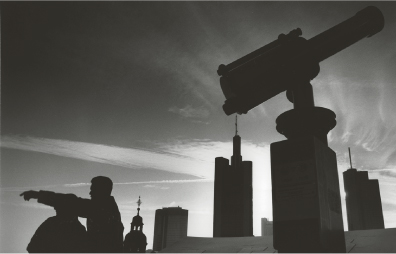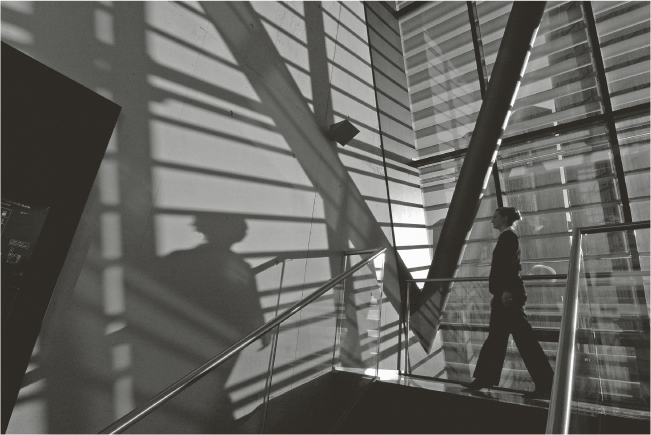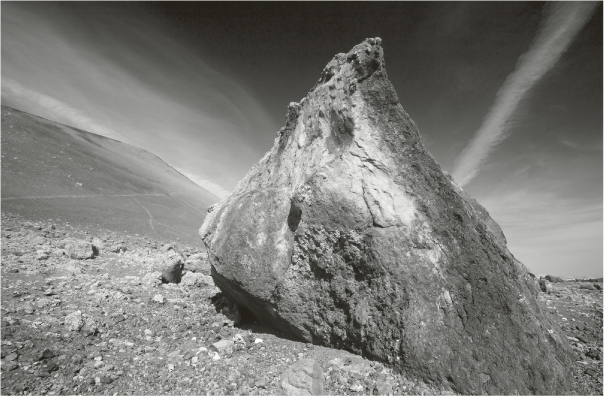18 Triangular Composition
Triangular composition is one of the best-known classical ways of composing an image. The triangle is a harmonic entity, and this is especially true of isosceles or equilateral triangles, which are optically harmonious. In older buildings, pointed roofs were often built with exactly the same angles so they would form an equilateral triangle.
The well-known German romantic painter Caspar David Friedrich often composed his canvases with a pair of compasses and a geometry triangle to attain triangular composition in his paintings—to the point of even frequently arranging the clouds in his majestic skies in the shape of a triangle.
As far as photography is concerned, the same principles used in classical painting apply; the difference is that you must search your surroundings to find so-called “optical triangles.” In a photo, you can either hint at or clearly show a triangle. The optical triangle in a photo has a very orderly, harmonizing function, similar to the golden ratio, but it can also have an excessively static effect that is perceived as too rigid. Although generally static, you can use an optical triangle to create a dynamic composition, such as using a blurred movement to create a triangular shape.
Dynamic Triangle
The photo in figure 18–1 typifies the modern pictorial language that is featured in photojournalism. It is an example of how you can create dynamic photographs with the help of triangular composition.
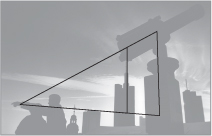
What characterizes a dynamic composition? Dynamic compositions live from oblique or diagonal lines, especially when movement is suggested. It’s no accident that modern photography so often works with blurred movement, which has almost become a fad.
The dynamic quality of this photo is created by two opposite elements that lead your eye out of the picture: The man points left and out of the image, and the large telescope leads your gaze to the right and out of the image. A strong pictorial tension results from these opposing elements. In addition, the telescope’s shape resembles the silhouetted Commerzbank skyscraper. We see that is enough to hint at an optical triangle at:
• The arm of the person represents the base of the triangle.
• The telescope’s pedestal represents the vertical side of this triangle.
• The telescope, continuing to the lower-left corner as an imaginary line until it reaches the man’s fingertip, represents the diagonal side.
Running counter to the triangle’s upward diagonal (which create this dynamic property), a streak of clouds runs parallel to the man’s arm. The composition would have lost most of its tension if the man had not raised his arm at that instant.
The photo was taken with an analog camera and a 20 mm wide-angle lens, which is highly suitable for dynamic compositions owing to its distorted perspective and significant depth of field.
Interlocking Triangles
If the optical triangles were only hinted at in the previous photo, they are clearly defined in figure 18–2:
• A triangle is formed by a sloping window strut, its shadow, and the upper corner of the image.
• Another triangle is formed by the dark area at the left edge of the picture.
• A triangle is formed by the oblique line of the dark area, the shadow of the first triangle described above, and the left railing.
The numerous oblique lines in this photo give the image its dynamic quality, yet the repeated optical triangles provide some order.
The slats of the window blinds and their shadows create an interesting graphic structure—yet even this entire architectural pattern would have been only half as interesting without the woman and her shadow. The human embedded within the architecture is the subject matter of this photo, which, by the way, has a touch of a “Hitchcock feel” in it, enough to make it interesting.
The photo was taken digitally using a 18 mm lens. It was important to make sure that the areas illuminated by the sun’s reflection did not lose their detail. To prevent this loss from occurring, the photo was underexposed by 1 ½ stops, and the shadow areas were slightly lightened with the Shadow/Highlight tool.
Central Triangle
Classically speaking, a triangular composition is regarded as rather static, so the following examples will show two relatively static photos, as opposed to the previous two dynamic compositions.
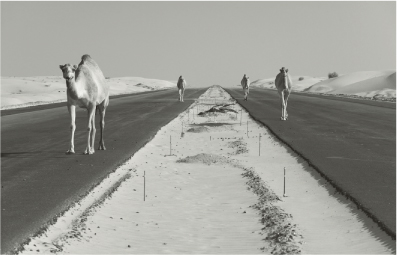
The simplest way to create a triangular composition is to use the vanishing point perspective present in just about every roadway on Earth. If you position yourself in the middle of any reasonably straight road and you don’t use a telephoto lens with too great a magnification, the scene thus formed will create an isosceles triangle. In figure 18–3, the sandy central divide between the two newly tarred lanes create the perspective effect. The humor in the image is obviously the presence of four camels on this not yet opened section of freeway in the United Arab Emirates. This counterpoint gives the image a surreal feel, and the viewer is compelled to ask what camels are doing on a freeway. The composition of the image benefits from its almost complete symmetry, even though the vanishing point isn’t quite in the horizontal center of the frame and the camel on the left is further ahead than the one on the right. If the photo had turned out completely symmetrical, it would have been too static anyway.
This was an authentic found scene which I was able to photograph because I failed to notice a couple of No Entry signs. If you are serious about your photography, you will have to overlook such signs every once in a while too.
Onion in Stone
Although a special stone is the subject matter of the photo in figure 18–4, the mood is also very important—emphasized by the dark sky and the vapor trail in the image’s right edge. These elements also create a second, imaginary optical triangle apart from the stone’s triangular shape. The base of this triangle is the photo’s upper edge, the first side is the right vapor trail, and the second side is the line formed by the distant mountains and another vapor trail to the left. Both sides penetrate the stone because the eye extends them all the way to their intersecting point in the lower part of the stone.
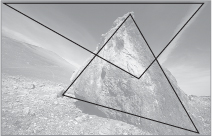
With this interesting, onion-shaped stone in Lanzarote it was necessary to “examine the object,” as former LIFE magazine photographer Feininger once said. By that, he meant to explore a subject by walking around it and carefully looking at it from every perspective. When exploring the subject, I decided to include the vapor trail in the composition because it was the most interesting element in the sky.
The photo was taken digitally with a 17 mm extreme-wide-angle lens and a full-format sensor. A somewhat hazy day called for a polarizing filter to be used. The photo now had a nice contrast, and a conversion to black and white using the Photoshop red filter preset did the rest to create a dark sky with a mystical effect.

